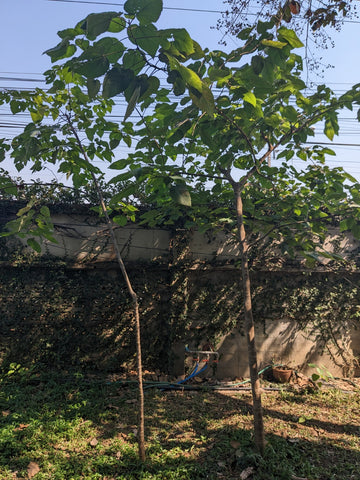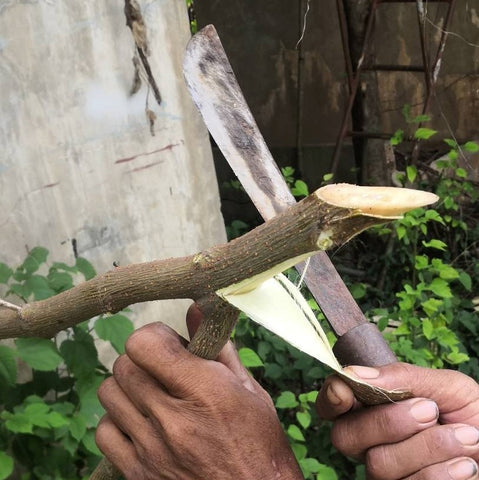Just about everything about kozo plants
Kozo papers are well-known among paper enthusiasts, but not many people know about the plant that that brings life to the papers. So, let’s dive in and explore the fascinating plant itself!
Kozo (paper mulberry) is a species of deciduous tree or large shrub in the mulberry family, Moraceae. The tree can normally grow 10-20 meters tall, and has smooth, gray bark. The blades of the plant can vary in shape, with some being lobed and others unlobed. However, they typically feature toothed edges, a light hairiness, pale undersides, and a rough texture. They can grow up to 15-20 cm in length. The plant also has distinct male and female flowers, which grow on separate plants. The tree produces small, greenish-white flowers in the spring. The fruit is a small, reddish-brown capsule.

Two happy kozo plants near our office.

Same tree, different leaves!
Paper mulberry was once grouped with other mulberries due to its close relation, but was later given its own genus, Broussonetia, named after botany professor Pierre Maria August Broussonet from Montpelier, France (1761-1807).
Kozo plant is native to Asia. Some scientific studies suggest that the plant might be originated from Taiwan. The paper mulberry is thought to be one of the most widely transported fiber crop in prehistory. It was carried along the full range of the Austronesian expansion, unlike most other commensal crops in Oceania. This crop can be found on almost every island or island group in Polynesia.
The most notable feature of kozo is its bark, which is used to make a type of paper known as our beloved "kozo paper." The fibers of the bark are long, strong, and relatively uniform in size, which makes them well-suited for papermaking. The bark is typically harvested in the spring or early summer and is processed by boiling and pounding to separate the fibers. The fibers are then cleaned, beaten, and formed into sheets of paper.

Peeling the bark of kozo branch.
The earliest known use of paper made from kozo was in China during the Han Dynasty (206 BC - 220 AD). The plant was then introduced to Japan in the 6th century AD, where it quickly became the primary material used for papermaking. The process of making paper from kozo involves stripping the inner bark of the plant, pounding it into a pulp, and then forming it into sheets. Known for its durability and longevity, kozo paper is still used today in traditional and modern arts such as calligraphy and printmaking, as well as for making various crafts such as decoupage, bookbinding, and lamp shading.
Additionally, the fruit and cooked leaves of the plant are edible. In traditional medicine, the fruit, leaves, and bark have been utilized, with the bark and fruit being used as a laxative and antipyretic in rural Pakistan. Ornamentally, it is a versatile plant, tolerant of disturbance and air pollution, making it suitable for landscaping on roadsides. As a pioneer species, it easily fills forest clearings, making it a potential option for reforestation efforts. It can thrive in a variety of climate conditions. Unfortunately, the ability to adapt and spread rapidly also make kozo plant an invasive species in some countries.
In conclusion, the kozo plant is a versatile and valuable resource that has been used for centuries in various forms of crafts. The fibers of the kozo plant have proven to be strong, durable, and beautiful. As interest in sustainable and Eco-friendly materials continues to grow, the kozo paper may become more popular in the future!







